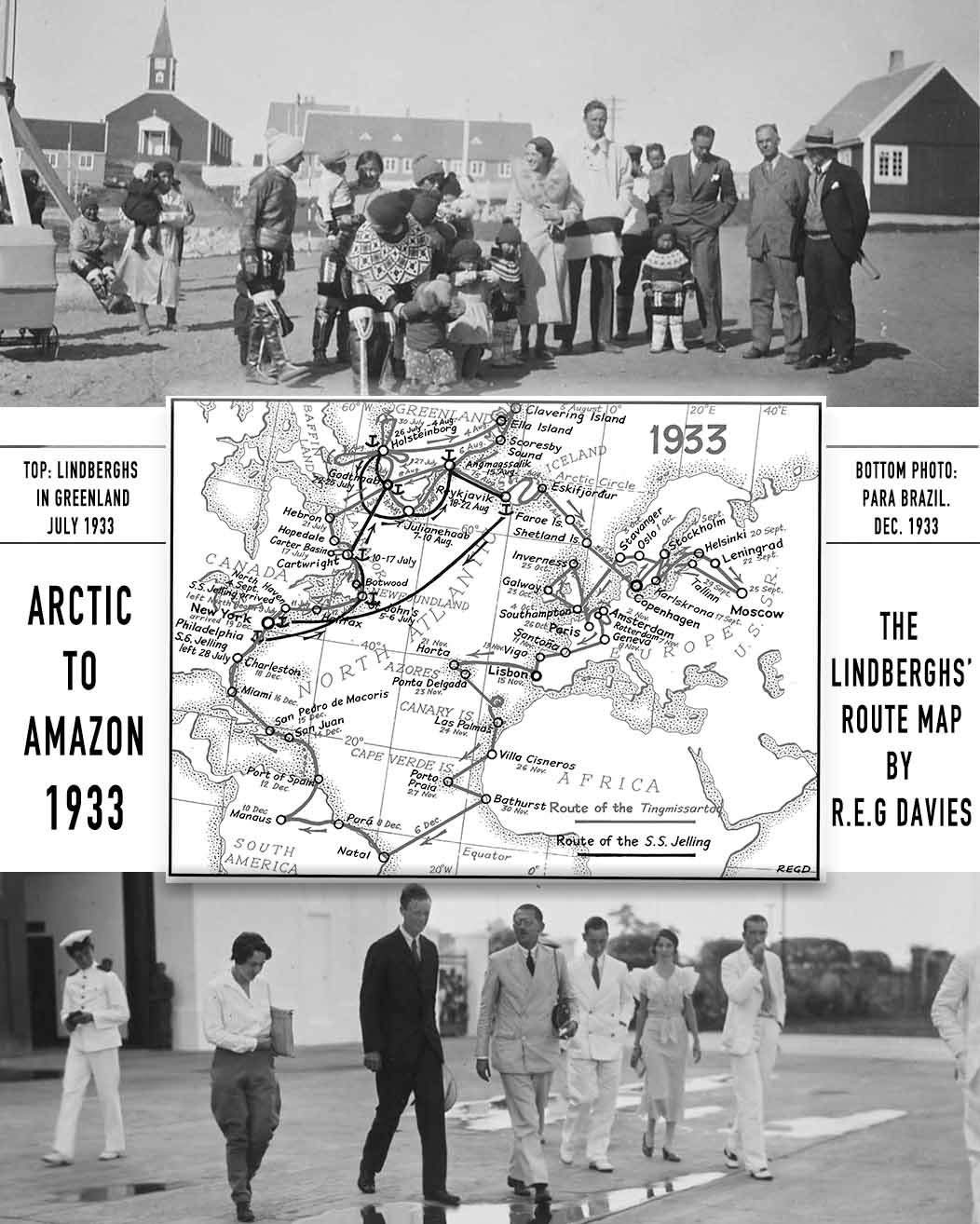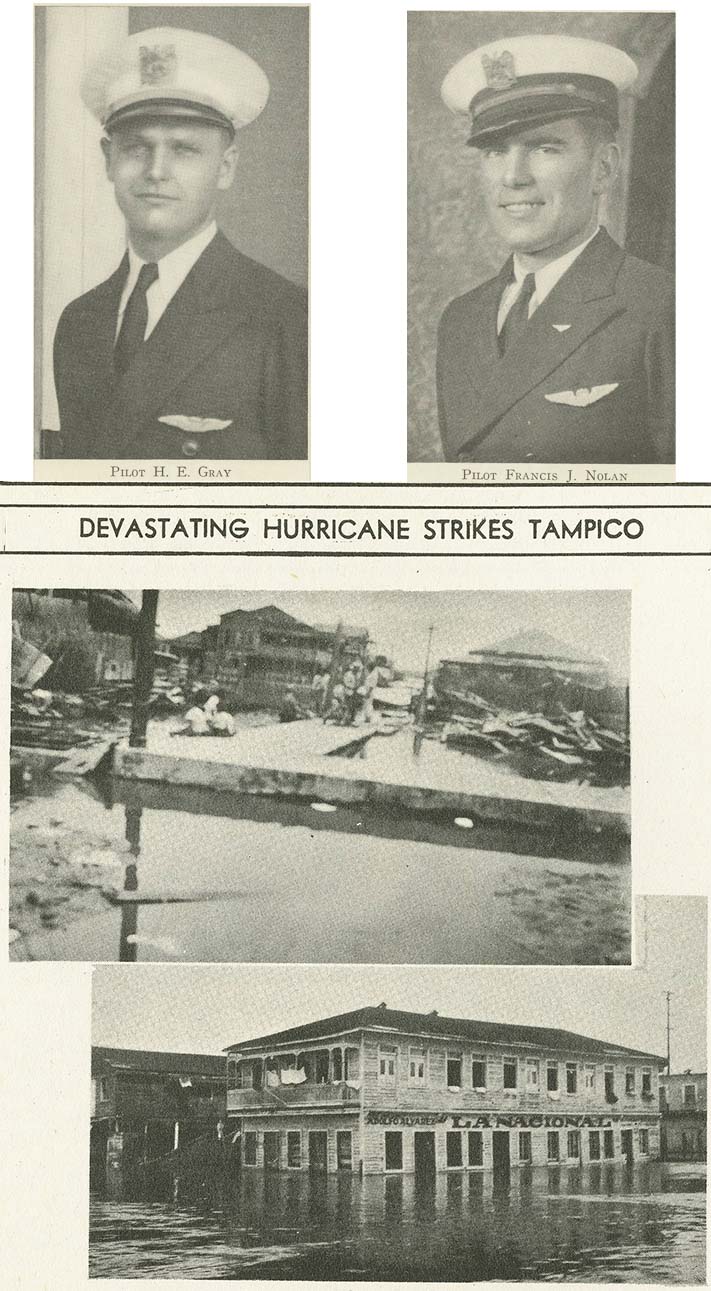DECEMBER 1933

Dec. 6, 1933
“New 1933 Milestones”

Photo compilation (PAHF Collection) Top to bottom: • Panagra DC-2 flying over the Andes. • Pan Am Consolidated Fleetster on skis. • Pacific Alaska Airways L-10 Electra flying over Juneau.
By Dec.1933 Pan Am had planned to acquire new, more powerful, land planes for its fleet. An order for 18 Douglas DC-2 aircraft on 12/09 was followed 4 days later by another, on 12/13, for 12 smaller, but faster, twin-engine Lockheed L-10 Electras.
The DC-2s, equipped to carry 18 passengers, were delivered to Pan Am over a period of 4 years, beginning in the summer of 1934 through mid-1937. They were sent primarily to Pan Am’s affiliates — Panagra, Mexicana and China National Aviation Corporation (CNAC). One DC-2 delivered in 1936 was “believed to have been used” in Alaska (R.E.G. Davies).
For the most part, the smaller L-10 Electras carrying up to 12 passengers, flew in Latin America for Aerovías, Compañía Mexicana de Aviación (CMA), Cubana and Panair do Brasil. According to Davies, seven of them also worked at one time or another for affiliate, Pacific Alaska Airways.
Pan Am’s in-house historian Althea “Gerry” Lister wrote about successful improvements made for the growing land plane fleet in Alaska during 1933. That year, Pan American
• designed and built the first portable furnace equipped with blowers for pre-heating engines…
• modified three "Consolidated Fleetsters" for Arctic operations…
• constructed a modern hangar and improved maintenance base at Fairbanks, Alaska…
• developed, in conjunction with manufacturers, skis, using laminated wood boards with pedestals constructed of cast-aluminum alloy and incorporating a hydraulic shock-strut.”

Dec. 14, 1933
“The Travels of Marjorie Shuler"

Photo compilation
•Marjorie Shuler, "Pan American Air Ways," March 1934, p.7.
•Pan Am Route Map of Latin America, 1932 (PAHF Collection).
December 15, 1933 marked the beginning of air travel adventures for Marjorie Shuler, noted author-lecturer, suffragist, and good friend of Eleanor Roosevelt. At the time, Pan Am -- along with affiliates Panair do Brasil and Panagra -- was America's foremost and most far-reaching airline.
According to Pan Am historian Gerry Lister, on that day Shuler embarked on a journey on behalf of the prominent Christian Science Monitor newspaper. She made a complete circle of South America and the Amazon River, covering a distance of 20,000 miles on land planes and flying boats.
When her trip around South America ended, Shuler admitted that at first she didn't want to fly, having flown only once before, from London to Paris, and finding that experience less than agreeable. In contrast, her travels around South America on Pan Am convinced her that flying was a great way to go. She discovered the Pan Am staff on the ground and in the air were friendly, helpful, and willing to go out of their way to make their passengers comfortable.
The Pan Am trip had an impact on her writing, lecturing, and on her future travels. By 1939, Marjorie Shuler became the first woman to fly all the way around the globe on commercial aircraft. Although her trip wasn't a continuous undertaking, she began and ended her journey in Marseilles, France between June 1938 and June 1939. She published a serial about her excursions in the Monitor during that time, and crafted her story into a book, "A Passenger to Adventure: Reminiscences of an Aeroplane Voyage Around the World."
While circling the globe, Shuler flew Pan Am on both the transpacific and transatlantic legs of her trip. She took the Martin M-130 "China Clipper" Manila-to-San Francisco. She also flew on the Boeing B-314 "Atlantic Clipper," New York-Azores-Lisbon-Marseilles, a press preview flight that was only the fifth journey for a transatlantic clipper (the previous four were mail-only flights).
In addition to her feminist legacy, Marjorie Shuler had a very positive influence on public acceptance of air travel, especially for women.
• "Famous Writer describes her Pan American Flight," Pan American Air Ways, March 1934, p.7. University of Miami Special Collections, https://digitalcollections.library.miami.edu/digital/collection/asm0341/id/50303/rec/13
• Stanford University Copyright Renewals Catalog https://exhibits.stanford.edu/copyrightrenewals/catalog/R416921

Dec. 20, 1933
“From Arctic to Amazon"

Photos : ”Pan American Arctic survey flight: Greenland to Iceland transatlantic route, Charles A. Lindbergh, 1933.” UM_Spec_Coll.: • Lindberghs, Greenland, p. 30. • Lindberghs, Para, Brazil & Paul Kuzmick, Chief Engineer for Panair do Brasil, 1933, p. 53.(”… the plane being like a race horse, finally back in its own stable," p.175, Anne Morrow Lindbergh, from "Locked Rooms and Open Doors.)” • Route Map, "Atlantic Epic, 1933," from "Charles Lindbergh, An Airman his Aircraft and his Great Flights," by R.E.G. Davies, illustrated by Mike Machat, 1997, Paladwr Press, p. 45.
MIAMI Dec. 16, 1933: A celebrated team- Pilot Charles Lindbergh & Radio Operator Anne Morrow Lindbergh-arrived from a 5-month, 21-country, 30,000-mile survey to map aerial pathways across the Atlantic. Their tiny monoplane, a Lockheed Sirius equipped with sliding cover for the cockpit, pontoons and extra fuel tanks, had been named the “Tingmissartoq” in Greenland.
The plane flew the Lindberghs through Canada’s Maritime provinces to Greenland’s glacial core, across the North Atlantic through Europe, down to Africa’s western shore, across the South Atlantic to Brazil’s northeast shoulder, & up the Amazon to Manaus before returning to the US.
The Danish SS Jelling, chartered by Pan Am, was a home base for scientific studies & Lindbergh's flights over Greenland. The Lindberghs flew to Iceland, east to Scandinavia & Russia, and south to Spain & Africa. They were welcomed by officials everywhere, facing bad weather throughout, but were equipped to stay overnight on the “Tingmissartoq” when necessary, often managing routine maintenance themselves. In early Dec. they flew back across the Atlantic from Bathurst Gambia after several failed attempts to take off. Greatly lightening their load, they finally headed for Natal on a flight that required blind flying with little-to-no radio contact until they were nearly half way there.
On their trip the Lindberghs compiled climate and geographical information that helped shape the future for Pan Am’s transatlantic service by the big Clippers in 1939.

Dec. 27, 1933
“Pan Am Looks to 1934"

Photo compilation: •Concept drawings, clockwise: Fairchild Amphibian / Douglas DC-2 / Lockheed Electra / Sikorsky S-42. "Pan American Air Ways," Jan.-Feb. 1934, Vol. 5, No. 1, pp. 1,4 & 5. (PAHF collection). •Photo: Port Washington Seaplane base, 1937 •Photo: Lindbergh’s arrival at Miami Dinner Key Seaplane Base, Dec. 1933. "Pan American Arctic survey flight: Greenland to Iceland transatlantic route, Charles A. Lindbergh, 1933," p. 56. https://digitalcollections.library.miami.edu/digital/collection/asm0341/id/197013/rec/1
In 1933, its 6th year of operation, as noted in Pan Am's newspaper, "Pan American Air Ways," the company
•Added 4,330 miles of operating airways to the basic system…
•Had highly developed mail, passenger and express transport service…
•Operated a network of over 30,982.5 miles of airways…
•Linked the US on direct aerial trade routes to every country but 2 in the Western Hemisphere…
•Had important outposts firmly established in Alaska and in the strategic center of Far East trade, China.
New International Planes: Following a development program adopted in early 1933, Juan Trippe ordered new planes to provide Pan Am with the largest fleet of the most advanced transports in the world. A new type of Fairchild amphibian could fly 180 mph, with retractable landing gear and floats for river routes in Latin America. New land planes —Douglas DC-2s — could fly up to 200 mph and fly in high altitudes on Panagra’s Andes routes. Orders of Lockheed Electras capable of flying 215 mph, were slated for Mexico and Central America routes.
And finally, after 18 months of development in accordance with Juan Trippe’s 1931 specifications, the Sikorsky S-42 flying boat — “Pan American’s New Ocean Greyhound” — was unveiled. It was scheduled to be tested early 1934 (Pan American Air Ways Jan,- Feb. 1934, p. 20).
Two Seaplane Bases: Pan Am established a vital seaplane base in Port Washington in 1933, not far from New York City. By December, when the Lindberghs returned from their epic survey, Pan Am had finished dredging and filling Miami’s Dinner Key to complete construction of a contemporary Art Deco building for flying boat passengers, replacing Pan Am's houseboat station. The permanent Dinner Key marine terminal would open early 1934.

Dec. 31, 1933
"A Second Havana Route"

Photo compilation: Tampa-Havana Trial Service Adds New Leg to System Network, "Pan American Air Ways," 5.1, January 1934, p. 7. University of Miami Special Collections, Pan American World Airways, Inc. records. https://digitalcollections.library.miami.edu/digital/collection/asm0341/id/50048/rec/1
As “American Clipper” (Sikorsky S-40, NC80V) departed Tampa Bay, in early December 1933, R.O.D. Sullivan (Captain), E.B. Lemmon (Airport Manager), Tildo Carrero (Traffic Manager), William Skrimshire (Clearance Manager), C.C. Asher (Chief Mechanic) had invested weeks in Pan American Airway’s newest international service. While his colleagues did the ground work, Sullivan drummed up business flying publicity flights above Tampa Bay.
Tampa officials had lobbied Pan Am for “an air route to Havana and a direct connection” to the company’s full route system. Pan American Air Ways reported, “Tampa is constructing a seaplane base including a ramp, pier, stores building and a passenger terminal containing space for government port offices, and facilities for air-line administrative personnel.”
Delayed twenty minutes by fog, Sullivan’s first flight, December 4, took 3 hours and 15 minutes, an hour longer than the Miami to Havana flight, and the route’s viability was never in question after that flight. Service followed a Monday, Wednesday, Friday 8:00 a.m. departure/Tuesday, Thursday, Saturday 1:45 p.m. return, using Consolidated Commodores flown by a rotating senior-pilot cadre.
Source:
"Pan American Air Ways," 4.5, October,1933 p. 5. University of Miami Special Collections, Pan American World Airways, Inc. records. https://digitalcollections.library.miami.edu/digital/collection/asm0341/id/41147/rec/5

